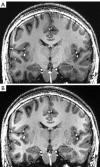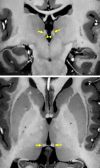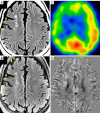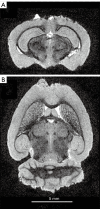Neuroimaging at 7 Tesla: a pictorial narrative review
- PMID: 35655840
- PMCID: PMC9131333
- DOI: 10.21037/qims-21-969
Neuroimaging at 7 Tesla: a pictorial narrative review
Abstract
Neuroimaging using the 7-Tesla (7T) human magnetic resonance (MR) system is rapidly gaining popularity after being approved for clinical use in the European Union and the USA. This trend is the same for functional MR imaging (MRI). The primary advantages of 7T over lower magnetic fields are its higher signal-to-noise and contrast-to-noise ratios, which provide high-resolution acquisitions and better contrast, making it easier to detect lesions and structural changes in brain disorders. Another advantage is the capability to measure a greater number of neurochemicals by virtue of the increased spectral resolution. Many structural and functional studies using 7T have been conducted to visualize details in the white matter and layers of the cortex and hippocampus, the subnucleus or regions of the putamen, the globus pallidus, thalamus and substantia nigra, and in small structures, such as the subthalamic nucleus, habenula, perforating arteries, and the perivascular space, that are difficult to observe at lower magnetic field strengths. The target disorders for 7T neuroimaging range from tumoral diseases to vascular, neurodegenerative, and psychiatric disorders, including Alzheimer's disease, Parkinson's disease, multiple sclerosis, epilepsy, major depressive disorder, and schizophrenia. MR spectroscopy has also been used for research because of its increased chemical shift that separates overlapping peaks and resolves neurochemicals more effectively at 7T than a lower magnetic field. This paper presents a narrative review of these topics and an illustrative presentation of images obtained at 7T. We expect 7T neuroimaging to provide a new imaging biomarker of various brain disorders.
Keywords: 7 Tesla (7T); MP2RAGE; functional magnetic resonance imaging (fMRI); magnetic resonance spectroscopy (MRS); susceptibility.
2022 Quantitative Imaging in Medicine and Surgery. All rights reserved.
Conflict of interest statement
Conflicts of Interest: All authors have completed the ICMJE uniform disclosure form (available at https://qims.amegroups.com/article/view/10.21037/qims-21-969/coif). TO receives a research grant from Siemens Healthcare K.K., Japan and the JSPS (21H03806). TO serves as an unpaid editorial board member for Quantitative Imaging in Medicine and Surgery. NS and TM receive grants from AMED (21dm0307003h0004 and 21dm0307102h0003, respectively). The other authors have no conflicts of interest to declare.
Figures

















Similar articles
-
Evaluating the role of 7-Tesla magnetic resonance imaging in neurosurgery: Trends in literature since clinical approval.World J Radiol. 2024 Jul 28;16(7):274-293. doi: 10.4329/wjr.v16.i7.274. World J Radiol. 2024. PMID: 39086607 Free PMC article.
-
Key clinical benefits of neuroimaging at 7T.Neuroimage. 2018 Mar;168:477-489. doi: 10.1016/j.neuroimage.2016.11.031. Epub 2016 Nov 13. Neuroimage. 2018. PMID: 27851995 Free PMC article. Review.
-
3 versus 7 Tesla magnetic resonance imaging for parcellations of subcortical brain structures in clinical settings.PLoS One. 2020 Nov 24;15(11):e0236208. doi: 10.1371/journal.pone.0236208. eCollection 2020. PLoS One. 2020. PMID: 33232325 Free PMC article.
-
Seven Tesla MRI in Alzheimer's disease research: State of the art and future directions: A narrative review.AIMS Neurosci. 2023 Dec 11;10(4):401-422. doi: 10.3934/Neuroscience.2023030. eCollection 2023. AIMS Neurosci. 2023. PMID: 38188012 Free PMC article. Review.
-
A closer look: pediatric neuroimaging at 7T.Pediatr Radiol. 2025 May;55(6):1071-1087. doi: 10.1007/s00247-025-06231-4. Epub 2025 Apr 21. Pediatr Radiol. 2025. PMID: 40257498 Review.
Cited by
-
Prefrontal cortex neurons encode ambient light intensity differentially across regions and layers.Nat Commun. 2024 Jun 29;15(1):5501. doi: 10.1038/s41467-024-49794-w. Nat Commun. 2024. PMID: 38951486 Free PMC article.
-
Brain Morphometrics Correlations With Age Among 350 Participants Imaged With Both 3T and 7T MRI: 7T Improves Statistical Power and Reduces Required Sample Size.Hum Brain Mapp. 2025 Mar;46(4):e70195. doi: 10.1002/hbm.70195. Hum Brain Mapp. 2025. PMID: 40083197 Free PMC article.
-
Value of susceptibility-weighted imaging in differentiating benign from malignant portal vein thrombosis.Quant Imaging Med Surg. 2023 Apr 1;13(4):2688-2696. doi: 10.21037/qims-22-350. Epub 2022 Oct 25. Quant Imaging Med Surg. 2023. PMID: 37064354 Free PMC article.
-
Effect of cannabinoids on glutamate levels in the human brain: a systematic review and meta-analysis.J Cannabis Res. 2025 Apr 21;7(1):21. doi: 10.1186/s42238-025-00277-9. J Cannabis Res. 2025. PMID: 40259403 Free PMC article. Review.
-
'How does it make you feel?' Reclaiming subjectivity in neuroscience.Brain Neurosci Adv. 2025 May 9;9:23982128251339567. doi: 10.1177/23982128251339567. eCollection 2025 Jan-Dec. Brain Neurosci Adv. 2025. PMID: 40353066 Free PMC article. No abstract available.
